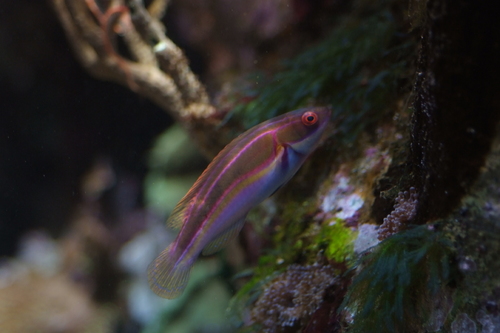
Laboute's Fairy Wrasse
The Atlantic bluefin tuna (Thunnus thynnus) is a majestic and powerful fish, renowned for its size, speed, and commercial value. It plays a critical role in the marine ecosystem and has been a prized catch for centuries. Unfortunately, this magnificent species has been severely impacted by human activities.
3 5 years
Lifespan
12 cm
Length
Least Concern
Conservation Status
15 km/h
Swimming speed
Planktivorous, Carnivorous
Diet
Sedentary
Migration
Appearance Overview
The Atlantic bluefin tuna is a large, streamlined fish with a metallic blue body and a silvery underside.
Coloration
Dark metallic blue on top, silvery-white on the bottom
Body Shape
Torpedo-shaped, built for speed and endurance
Fins
Two dorsal fins, the first is yellow or blueish, the second is reddish-brown
Length
Up to 13 feet (4 meters)
Weight
Up to 2,000 lbs (900 kg)
Diet
Carnivorous, feeding on a variety of fish, squid, crustaceans, and eels.
Feeding Behavior
Opportunistic predators, they hunt by sight and are known for their incredible speed and agility. They often hunt cooperatively, herding prey into tight formations.
Social Behavior
Highly migratory, forming large schools, especially during spawning season. They exhibit complex social behaviors within their schools.
Commercial Relevance
Extremely high value, especially in the sushi and sashimi markets of Japan. It is one of the most expensive fish species globally.
Conservation measures
International fishing quotas, strict regulations on fishing gear, and efforts to establish marine protected areas. Ongoing monitoring of populations is also crucial.
Status
Endangered
Threats
Overfishing (historically the biggest threat), bycatch in fishing gear, and climate change affecting their prey distribution and spawning grounds.
Habitat Distribution
Depth Range
0-1,000 meters (0-3,280 feet), but they are most commonly found in surface waters.
Geographic Range
Western and Eastern Atlantic Ocean, Mediterranean Sea.
Preferred Environment
Temperate and subtropical waters; they prefer open ocean environments but also venture into coastal areas.
Reproduction and Life Cycle
Breeding Habits
Spawns in warm waters, primarily in the Mediterranean Sea and the Gulf of Mexico. Spawning occurs during specific times of the year, typically in spring and summer.
Development Stages
Eggs hatch into larvae, which drift with the currents. Juveniles grow rapidly, feeding and migrating. They develop into adults over several years.
Fecundity
Females are highly fecund, releasing millions of eggs (up to 30 million) per spawning season.
Maturity Age
Reaches sexual maturity relatively late, around 4-8 years in the western Atlantic and earlier in the eastern Atlantic.
Faqs about Laboute's Fairy Wrasse
Where are Atlantic bluefin tuna found?
Atlantic bluefin tuna are found in the western and eastern Atlantic Ocean, as well as the Mediterranean Sea.
How long do bluefin tuna live?
They can live up to 40 years, although many don't reach that age due to fishing pressure.
Are bluefin tuna migratory?
Yes, they are highly migratory, traveling vast distances across the Atlantic Ocean for feeding and spawning.
Do bluefin tuna have any predators?
They are apex predators, meaning they are at the top of the food chain and have few natural predators when fully grown. Sharks, orcas, and other large predators prey on juvenile tuna.
Can I eat bluefin tuna?
It's recommended to choose alternatives or check for sustainably sourced options, as the species is endangered.
How fast can the Atlantic bluefin tuna swim?
The speed record is around 55 mph.
Copyright @ Nature Style Limited. All Rights Reserved.
 English
English